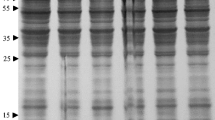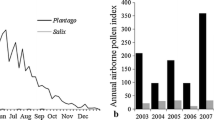Abstract
Air pollutants impact airborne pollen biochemistry. Oxidative damage to lipids, proteins and nucleic acids or protein nitration are among ozone (O3) and nitrogen dioxide (NO2) described deleterious effects possibly causing pollen physiology damage and enhanced allergenic activity, contributing to aggravate pollen driven respiratory allergy in urban areas. The goal of this research was to evaluate the effects of O3, NO2, alone and combined, on Dactylis glomerata pollen reactive oxygen species scavenging enzymes, on pollen germination and their potential contribution to the allergenicity. D. glomerata pollen was in vitro exposed to pollutants. Protein extracts were prepared and superoxide dismutase (SOD), catalase and glutathione peroxidase (GPx) activities were evaluated. Western blot with pooled sera or with IgG against group 5 allergens and profilin was performed. Pollen germination capacity was increased by NO2 and was unaffected by O3 or O3 + NO2 but showed longer pollen tubes in the latter. Exposure to O3 did not affect SOD activity but induced a twofold increase in catalase activity. SOD activity was twofold higher in pollen exposed to NO2. Exposure to O3 + NO2 induced a twofold and fivefold increase of SOD and catalase activities, respectively. Pollen GPx was unaffected by the pollutants. IgE-recognition of proteins in the molecular weight range of 42–57 kDa were amplified by NO2 and O3 + NO2 and O3 amplified proteins with molecular weight of 13 (profilin), 29 (Group 5), and 31 kDa. Taken together, these results show that pollen oxidative defences are activated by common air pollutants affecting both its germination capacity and its allergenic activity.





Similar content being viewed by others
Abbreviations
- ROS:
-
Reactive oxygen species
- SOD:
-
Superoxide dismutase
- GPx:
-
Glutathione peroxidase
- tBH:
-
t-Butyl hydroperoxide
References
Bailey-Serres, J., & Mittler, R. (2006). The roles of reactive oxygen species in plant cells. Plant Physiology, 141(2), 311. https://doi.org/10.1104/pp.104.900191
Bailly, C., Leymarie, J., Lehner, A., Rousseau, S., Come, D., & Corbineau, F. (2004). Catalase activity and expression in developing sunflower seeds as related to drying. Journal of Experimental Botany, 55(396), 475–483. https://doi.org/10.1093/jxb/erh050
Beauchamp, C., & Fridovich, I. (1971). Superoxide dismutase: improved assays and an assay applicable to acrylamide gels. Analytical biochemistry, 44(1), 276–87. https://www.ncbi.nlm.nih.gov/pubmed/4943714. Accessed 7 Apr 2017
Beligni, M. V., & Lamattina, L. (2000). Nitric oxide stimulates seed germination and de-etiolation, and inhibits hypocotyl elongation, three light-inducible responses in plants. Planta, 210(2), 215–221. https://doi.org/10.1007/PL00008128
Bortoli, D., Silva, A. M., Costa, M. J., Domingues, A. F., & Giovanelli, G. (2009). Monitoring of atmospheric ozone and nitrogen dioxide over the south of Portugal by ground-based and satellite observations. Optics Express, 17(15), 12944. https://doi.org/10.1364/oe.17.012944
Bradford, M. M. (1976). A rapid and sensitive method for the quantitation of microgram quantities of protein utilizing the principle of protein-dye binding. Analytical Biochemistry, 72(1–2), 248–254. https://doi.org/10.1016/0003-2697(76)90527-3
Bright, J., Hiscock, S. J., James, P. E., & Hancock, J. T. (2009). Pollen generates nitric oxide and nitrite: a possible link to pollen-induced allergic responses. Plant Physiology and Biochemistry, 47(1), 49–55. https://doi.org/10.1016/j.plaphy.2008.09.005
Buters, J., Prank, M., Sofiev, M., Pusch, G., Albertini, R., Annesi-Maesano, I., et al. (2015). Variation of the group 5 grass pollen allergen content of airborne pollen in relation to geographic location and time in season the HIALINE working group. Journal of Allergy and Clinical Immunology, 136(1), 87-95.e6. https://doi.org/10.1016/j.jaci.2015.01.049
Cauneau-Pigot, A. (1991). Effects of freeze-drying upon in vitro germination and the mineral composition of allergenic dactylis glomerata pollen. Grana, 30(2), 547–552. https://doi.org/10.1080/00173139109432024
Chassard, G., Choël, M., Gosselin, S., Vorng, H., Petitprez, D., Shahali, Y., et al. (2015). Kinetic of NO2 uptake by Phleum pratense pollen: Chemical and allergenic implications. Environmental Pollution, 196, 107–113. https://doi.org/10.1016/j.envpol.2014.10.004
Chehregani, A., Majde, A., Moin, M., Gholami, M., Ali Shariatzadeh, M., & Nassiri, H. (2004). Increasing allergy potency of Zinnia pollen grains in polluted areas. Ecotoxicology and Environmental Safety, 58(2), 267–272. https://doi.org/10.1016/J.ECOENV.2003.12.004
Conti, A., Alessio, M., Pesca, M., Soldarini, A., Breda, D., Pigatto, P. D., & Burastero, S. E. (2014). Phleum pratense manganese superoxide dismutase identified by proteomic: A new candidate grass allergen. Annals of Allergy, Asthma and Immunology. https://doi.org/10.1016/j.anai.2013.12.015
Cortegano, I., Civantos, E., Aceituno, E., Del Moral, A., López, E., Lombardero, M., et al. (2004). Cloning and expression of a major allergen from Cupressus arizonica pollen, Cup a 3, a PR-5 protein expressed under polluted environment. Allergy: European Journal of Allergy and Clinical Immunology., 59(5), 485–490. https://doi.org/10.1046/j.1398-9995.2003.00363.x
Cuinica, L. G., Abreu, I., & Esteves da Silva, J. (2014). Effect of air pollutant NO2 on Betula pendula, Ostrya carpinifolia and Carpinus betulus pollen fertility and human allergenicity. Environmental Pollution, 186, 50–55. https://doi.org/10.1016/J.ENVPOL.2013.12.001
D’Amato, G., Pawankar, R., Vitale, C., Lanza, M., Molino, A., Stanziola, A., et al. (2016). Climate change and air pollution: effects on respiratory allergy. Allergy, Asthma & Immunology Research, 8(5), 391–395. https://doi.org/10.4168/aair.2016.8.5.391
Dafni, A. (1992). Pollination ecology: a practical approach. In D. Rickwood & B. D. Hames (Eds.), Pollination ecology: a practical approach. Oxford: Oxford University Press.
EACCI. (2014). Global atlas of allergy. https://www.eaaci.org/GlobalAtlas/GlobalAtlasAllergy.pdf. Accessed 16 Jan 2020.
Franze, T., Weller, M. G., Niessner, R., & Pöschl, U. (2005). Protein Nitration by polluted air. Environmental Science & Technology, 39(6), 1673–1678. https://doi.org/10.1021/ES0488737
Galan, C., Antunes, C., Brandao, R., Torres, C., Garcia-Mozo, H., Caeiro, E., et al. (2013). Airborne olive pollen counts are not representative of exposure to the major olive allergen Ole e 1. Allergy, 68(6), 809–812. https://doi.org/10.1111/all.12144
Ghiani, A., Aina, R., Asero, R., Bellotto, E., & Citterio, S. (2012). Ragweed pollen collected along high-traffic roads shows a higher allergenicity than pollen sampled in vegetated areas. Allergy, 67(7), 887–894. https://doi.org/10.1111/j.1398-9995.2012.02846.x
Ghiani, A., Bruschi, M., Citterio, S., Bolzacchini, E., Ferrero, L., Sangiorgi, G., et al. (2016). Nitration of pollen aeroallergens by nitrate ion in conditions simulating the liquid water phase of atmospheric particles. Science of the Total Environment, 573, 1589–1597. https://doi.org/10.1016/j.scitotenv.2016.09.041
Gottardini, E., Cristofolini, F., Paoletti, E., Lazzeri, P., & Pepponi, G. (2004). Pollen viability for air pollution bio-monitoring. Journal of Atmospheric Chemistry, 49(1–3), 149–159. https://doi.org/10.1007/s10874-004-1221-z
Gruijthuijsen, Y. K., Grieshuber, I., Stöcklinger, A., Tischler, U., Fehrenbach, T., Weller, M. G., et al. (2006). Nitration enhances the allergenic potential of proteins. International Archives of Allergy and Immunology, 141(3), 265–275. https://doi.org/10.1159/000095296
Hauser, M., Roulias, A., Ferreira, F., & Egger, M. (2010). Panallergens and their impact on the allergic patient. Allergy, Asthma and Clinical Immunology. https://doi.org/10.1186/1710-1492-6-1
Iriti, M., & Faoro, F. (2007). Oxidative stress, the paradigm of ozone toxicity in plants and animals. Water Air and Soil Pollution, 187(1–4), 285–301. https://doi.org/10.1007/s11270-007-9517-7
Keeley, J. E., & Fotheringham, C. J. (1997). Trace gas emissions and smoke-induced seed germination. Science, 276(5316), 1248–1250. https://doi.org/10.1126/science.276.5316.1248
Kleine-Tebbe, J. (2014). Grass pollen allergens. In I. Editors Akdis, C.A., & Agache (Ed.), Global atlas of allergy (p. 22). European Academy of Allergy and Clinical Immunology Publishers.
Laemmli, U. K. (1970). Cleavage of Structural Proteins during the assembly of the head of bacteriophage T4. Nature, 227(5259), 680–685. https://doi.org/10.1038/227680a0
Lu, S., Ren, J., Hao, X., Liu, D., Zhang, R., Wu, M., et al. (2014). Characterization of protein expression of Platanus pollen following exposure to gaseous pollutants and vehicle exhaust particles. Aerobiologia, 30(3), 281–291. https://doi.org/10.1007/s10453-014-9327-5
Mannervik, B. (1985). Glutathione peroxidase. Methods in Enzymology, 113, 490–495. https://doi.org/10.1016/s0076-6879(85)13063-6
Miranda, P., Coelho, F. E. S., Tomé, A. R., & Valente, M. A. (2001). 20th century Portuguese climate and climate scenarios. In F. D. Santos, K. Forbes, & R. Moita (Eds.), Climate change in Portugal. Scenatios, impacts and adaptation measures—SIAM. Executive summary and conclusions (pp. 23–84). Lisbon: Gradiva.
Monteiro, A., Miranda, A. I., Borrego, C., & Vautard, R. (2007). Air quality assessment for Portugal. Science of The Total Environment, 373(1), 22–31. https://doi.org/10.1016/J.SCITOTENV.2006.10.014
Pasqualini, S., Cresti, M., Del Casino, C., Faleri, C., Frenguelli, G., Tedeschini, E., & Ederli, L. (2015). Roles for NO and ROS signalling in pollen germination and pollen-tube elongation in Cupressus arizonica. Biologia Plantarum, 59(4), 735–744. https://doi.org/10.1007/s10535-015-0538-6
Pasqualini, S., Tedeschini, E., Frenguelli, G., Wopfner, N., Ferreira, F., D’Amato, G., & Ederli, L. (2011). Ozone affects pollen viability and NAD(P)H oxidase release from Ambrosia artemisiifolia pollen. Environmental Pollution (Barking, Essex: 1987), 159(10), 2823–30. https://doi.org/https://doi.org/10.1016/j.envpol.2011.05.003
Pessarakli, M., Kordrostami, M., Rabiei, B., & Ebadi, A. A. (2019). Oxidative stress in plants. In Handbook of plant and crop stress, fourth edition (pp. 85–92). Boca Raton: CRC Press. https://doi.org/https://doi.org/10.1201/9781351104609-6
Ribeiro, H., Duque, L., Sousa, R., & Abreu, I. (2013). Ozone effects on soluble protein content of Acer negundo, Quercus robur and Platanus spp. pollen. Aerobiologia, 29(3), 443–447. https://doi.org/10.1007/s10453-013-9291-5
Ribeiro, H., Duque, L., Sousa, R., Cruz, A., Gomes, C., Esteves da Silva, J., & Abreu, I. (2014). Changes in the IgE-reacting protein profiles of Acer negundo, Platanus x acerifolia and Quercus robur pollen in response to ozone treatment. International Journal of Environmental Health Research, 24(6), 515–527. https://doi.org/10.1080/09603123.2013.865716
Ring, J., Eberlein-Koenig, B., & Behrendt, H. (2001). Environmental pollution and allergy. Annals of Allergy, Asthma & Immunology, 87(6), 2–6. https://doi.org/10.1016/S1081-1206(10)62332-0
Rogerieux, F., Godfrin, D., Sénéchal, H., Motta, A. C., Marlière, M., Peltre, G., & Lacroix, G. (2007). Modifications of Phleum pratense Grass Pollen Allergens following artificial exposure to gaseous air pollutants (O3, NO2, SO2). International Archives of Allergy and Immunology, 143(2), 127–134. https://doi.org/10.1159/000099079
Sousa, R., Duque, L., Duarte, A. J., Gomes, C. R., Ribeiro, H., Cruz, A., et al. (2012). In vitro exposure of Acer negundo Pollen to atmospheric levels of SO2 and NO2: Effects on allergenicity and germination. Environmental Science & Technology, 46(4), 2406–2412. https://doi.org/10.1021/es2034685
Zar, J. H. (2014). Biostatistical analysis (5th ed.). New International: Pearson.
Zumdahl, S. (2009). Chemistry in the atmosphere. In H. Cheek (Ed.), Chemical principles (6th ed., pp. 176–180). Boston: Houghton Mifflin Company.
Acknowledgements
This work was funded by the European Union through the European Regional Development Fund, framed in COMPETE 2020 (Operational Programme Competitiveness and Internationalization), through the ICT project (UID/GEO/04683/2013) with reference POCI-01-0145-FEDER-007690, and by National Funds by the Portuguese Foundation for Science and Technology (FCT) through the projects PTDC/ATP-EAM/0817/2014 and UIDB/04683/2020—ICT (Institute of Earth Sciences). The authors thank Russell Alpizar-Jara, CIMA (Research Centre for Mathematics and Applications) and Department of Mathematics, School of Science and Technology, University of Évora, for reviewing the statistical analysis.
Author information
Authors and Affiliations
Corresponding author
Electronic supplementary material
Below is the link to the electronic supplementary material.
Rights and permissions
About this article
Cite this article
Galveias, A., Arriegas, R., Mendes, S. et al. Air pollutants NO2- and O3-induced Dactylis glomerata L. pollen oxidative defences and enhanced its allergenic potential. Aerobiologia 37, 127–137 (2021). https://doi.org/10.1007/s10453-020-09676-2
Received:
Accepted:
Published:
Issue Date:
DOI: https://doi.org/10.1007/s10453-020-09676-2




